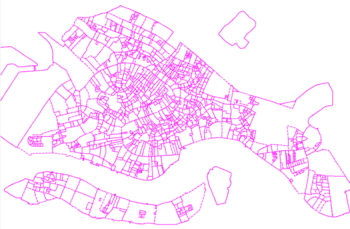Census tracts

Census tracts are small, relatively permanent statistical subdivisions of a geographical region in order to make census data more accurate and relevant. Census tracts are designed to be relatively homogenous with respect to population characteristics, economic status, and living conditions. Due to their small area, census tracts offer specific information for their regions. There are nearly 1200 census tracts in the historical center of the city.
Information Collected
There is a great deal of information collected in the census that is broken down into the census tracts. For personal demographics, the population is registered by gender and age in five year brackets. There is a good amount of commercial information collected also, such as the number of jobs in the area and what type of jobs there are.

Census in Italy
The census in Italy is carried out every ten years by the Istituto Nazionale di Statistica (ISTAT), the Italian national statistical institute. Created in 1926, its purpose is to collect and organize essential data on the nation, the census being one of its main activities. The past four censuses have taken place in 1971, 1981, 1991, the most recent being on October 21, 2001, and the next scheduled is 2011. In 2001, it was determined there was a total residential population of 56,995,744 people living on a land area os 301,328.45 square kilometers (116,343.565 square miles).
Relevance to Studying Venice
Census tracts offer a great view into how the city is broken up. There are a number of characteristics that make the city unique, one of which is the distinct difference between the Venetian neighborhoods. With the census tracts, you can get an accurate view of specific data pertaining to these regions, which can help better understand the city.
Census tracts are a great resource to use when studying Venetian Mobility as well. It can be determined what areas are primarily residential or commercial, and the number of jobs or residents are in that area. This information can be used to make assumptions as to where the majority of people will be travelling to commute to and from work, as well as where the majority of the people will be spending their time.